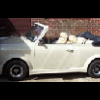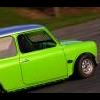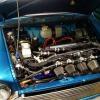
Clutch Pedal Wont Go All The Way Down

Best Answer The_Doc , 27 February 2025 - 05:02 PM
If changing the plate makes the difference then it must be the plate.
All I can think is the extra disc thickness means the diaphragm is compressed more so there's less travel before the pressure plate can bottom out on itself. If that happened you'd be pressing the whole assembly against the thrust bearings via the spring fingers so it should feel a little spongy. The throw out stop could be adjusted to stop that, but you'd still have the high pedal.
I think you've summarised it perfectly. Thanks all! Go to the full post

#1

Posted 23 February 2025 - 12:29 AM
But...the clutch pedal only goes halfway down. It then stops pretty firmly. The clutch seems to disengage (checked by rolling if back and forth in gear), but it's definitely not right.
The brief couple of times I drove it around the drive it definitely didn't feel like this. I've searched everything I can find on here and not seen anything similar.
It's almost like the diaphragm spring has lost all it's spring and bottoms out. But I don't understand how that can happen when I haven't driven it and it didn't do that before.
All advice welcome!
#2

Posted 23 February 2025 - 09:39 AM
Attached Files
#3

Posted 25 February 2025 - 11:44 AM
guess you forgot the 'top hat' then!!
#4

Posted 25 February 2025 - 11:52 AM
#5

Posted 25 February 2025 - 09:12 PM
Friction plate the right way round ![]()
#6

Posted 25 February 2025 - 09:37 PM
#7

Posted 25 February 2025 - 09:45 PM
Friction plate the right way round
Checked that. Not possible to do it wrong actually from what I can see. Thanks though.
#8

Posted 25 February 2025 - 09:47 PM
Hose breaking down internally and acting as a one way valve. Slave therefore getting pumped up and internal piston hitting end stop/circlip?
Already fitted a new hose, also slave has no circlip, I can push the piston right out with the pedal. It's 100% a mechanical issue.
I've also just replaced all of the lever arms, linkages etc. No difference.
I think the pressure plate is worn but no one I talk to seems to think that happens.
#9

Posted 26 February 2025 - 10:36 PM
#10

Posted 27 February 2025 - 11:06 AM
Probably nothing to do with it, but might be worth a read as not all replacement parts are fit for purpose.
https://www.theminif...ust-sleeve-fit/
#11

Posted 27 February 2025 - 02:58 PM
If changing the plate makes the difference then it must be the plate.
All I can think is the extra disc thickness means the diaphragm is compressed more so there's less travel before the pressure plate can bottom out on itself. If that happened you'd be pressing the whole assembly against the thrust bearings via the spring fingers so it should feel a little spongy. The throw out stop could be adjusted to stop that, but you'd still have the high pedal.
#12

Posted 27 February 2025 - 05:02 PM Best Answer
If changing the plate makes the difference then it must be the plate.
All I can think is the extra disc thickness means the diaphragm is compressed more so there's less travel before the pressure plate can bottom out on itself. If that happened you'd be pressing the whole assembly against the thrust bearings via the spring fingers so it should feel a little spongy. The throw out stop could be adjusted to stop that, but you'd still have the high pedal.
I think you've summarised it perfectly. Thanks all!
1 user(s) are reading this topic
0 members, 1 guests, 0 anonymous users

















